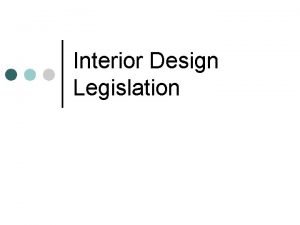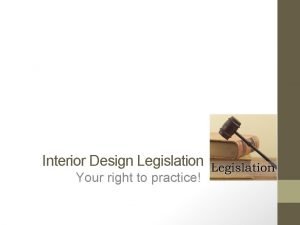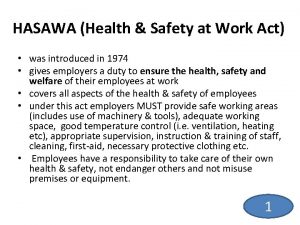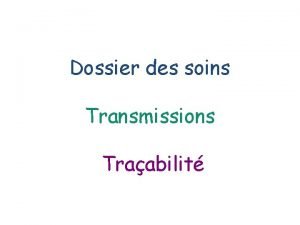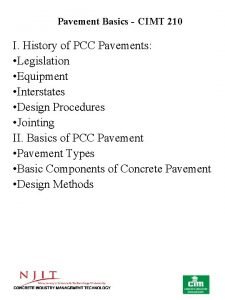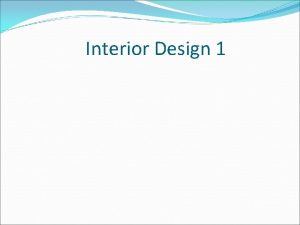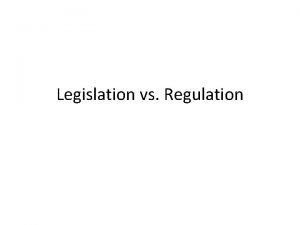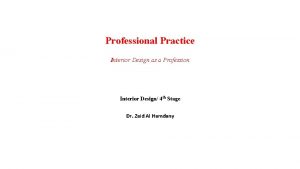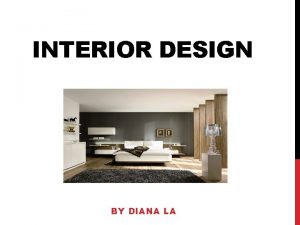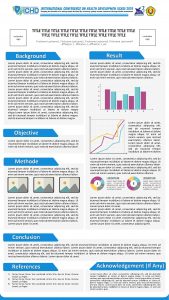Interior Design Legislation Your right to practice Title



































- Slides: 35

Interior Design Legislation Your right to practice!

Title vs Practice Act • Title Acts are laws that legislate the title of interior designer. In order to call yourself an interior designer, you may need certain requirements (varies by state) such as a CIDA education, NCIDQ exam and a specified number of years experience. • Practice Act is more stringent. This law stipulates who can practice interior design. • Question: Which state was the first to pass legislation?

Alabama was the first! • • • Title Act was introduced in 1982 Practice Act was in 2001 Now a Title Act in 2010 Registered Interior Designer Must be from a CIDA accredited school 2 years experience

Legislative Map

Opposition to Legislation • • • AIA NKBA Institute of Justice Interior Design Freedom Coalition (IDPC) Decorators

Enforcing Legislation • State licensing board • Fines for each incident (not project)

CEU’s • Continuing Education Units • Ranges from 5 – 10 hours per year of additional education • Must be related to health, safety and welfare • Obtained thru ASID and IIDA and must be IDCEC approved.

Chapter 2 Special Considerations in Design

Two Important Design Considerations • Design for special needs • • • ADA American with Disabilities Act of 1990 Universal Design Ambulatory impaired Hearing impaired Visual impaired Elderly • Environmental Considerations (later discussion) • Waste • Air pollution • Light and energy

What is ADA? • The ADA is a federal civil law signed into legislation on July 26 th, 1990 by President George Bush. • It prohibits discrimination against people with disabilities. • It is designed to make American society more accessible to persons with disabilities.

Background • The ADA laws became enforceable in 1992 and 1993. • The ADA is divided into 5 parts, regulating: – Employment – Public Services – Public Accommodations – Telecommunications – Miscellaneous

Part III: Public Accommodations • Refers mainly to accessibility requirement of public buildings including: – Hotels, restaurants, auditoriums, shopping centers, banks, hospitals, museums, libraries, educational facilities, child care centers, and recreational facilities – This is the section that designers will focus on.

Myths and Facts about ADA • MYTH: The ADA requires extensive renovation of all state and local government buildings to make them accessible. • FACT: The ADA requires all government programs, not buildings to be accessible. Not every building, nor each part of every building need to be accessible. Structural modifications are required only when there is no alternative available for providing program access. Example: A library has an inaccessible second floor. No elevator is needed if a staff member retrieves the books needed.

Myths and Facts about ADA • MYTH: Businesses must pay large fines when they violate the ADA • FACT: Courts may levy civil penalties only in cases brought by the Justice Department, not private litigants. The Department only seeks such penalties when the violation is substantial and the business has shown bad faith in failing to comply. The Department also considers a business’ size and resources in determining whether civil penalties are appropriate.

What is an accessible route? An accessible route is a continuous, unobstructed path connecting all accessible elements and spaces in a building or facility. This includes pathways, corridors, doorways, floors, ramps, elevators and clear floor space at fixtures.

RAMPS • Clear width shall be 44” • Landings shall be at least 60” in length • Slope rise to run ratio of 1: 12 • For every 30” rise, there should be an intervening flat area. • Handrails should extend 12” beyond the top and bottom ramp landings. • Handrails should have 1 ½” space between the handrail and wall.

Entrances, Exits, and Interior Routes • • • 36” Clear space beyond the latch side of the entrance door. 12 -18” clear space at latch side of interior doors. 32” clear width on door openings. Door hardware not higher than 48”. Lever style door hardware. Maximum opening force of 8. 5 lbs on exterior hinged doors. Maximum opening force of 5 lbs on interior doors. Threshold not higher than ½” with beveled edge. For two doors in a series, there must be 48” between the open doors. Sweep period of door closing should be at least 3 seconds. Signs must be provided to denote the accessible route. Floor area inside and outside each door should be level for a distance of 5’ from the direction the door swings. • Doors should be identified with either raised or indented letters/ numerals which identify the area. • Doors signs should be placed between 4’-6” – 5’-6” AFF.

Maneuvering Clearances

Obstructions • 80” clear headroom to avoid overhead hazards. (Includes alarms, and signs) • Routes should be clear of water fountains, pay phones and other protruding objects. Objects with their leading edges between 27 and 80” high shall not protrude more than 4” into the route. • Objects with their leading edge at 27” or below may protrude any amount as long as the route does not reduce pathway clearance below 36” wide. • One 60” x 60” passing space every 200 feet

Protruding Objects…

Accessible Controls

Stairs • Uniform step heights from 4” - 7” high • Tread depths at 11” • No overhang greater than 1 ½” • Handrails extend 12” past last step

Restrooms • • • At least one restroom is provide on an accessible route. Unobstructed 60” x 60” space for wheelchair turn around. Toilet should be 18” from centerline to wall or adjacent partition. Toilet seat should be 17”-20” high Stall door shall be 32” clear Standard accessible stall is 56” x 60” Grab bars at 33” – 36” AFF and 36” or 42” wide Lever style faucets Hot/cold pipe (if exposed) shall be covered Counter tops not higher than 34” AFF with at least 29” clearance from floor to top of apron. • Clear floor space in front of sink shall be 30” x 48” • Mirrors shall be mounted with the bottom edge mounted no higher than 40” AFF

Page 183 of The Codes Guidebook for Interiors

Lavatory Clearances

Drinking Fountains • One drinking fountain for every 75 occupants. • Each floor must have it’s own fountain. • If available, 50% should be accessible on each floor. • If only one available, is it on an accessible route. • Spout shall be no higher than 36” AFF • Recessed fountains shall have 24” maximum side walls and 30” minimum width. • Clear floor space of 30’ x 48”


Universal Design • Design that meets the needs of all users without drawing attention to persons with disabilities. • It is not the ADA. • Homes should be planned universally

Universal Design • Equitable Use: The design is useful and marketable to people with diverse abilities. • Flexibility in Use: The design accommodates a wide range of individual preferences and abilities. • Simple and Intuitive Use: Use of the design is easy to understand, regardless of the user's experience, knowledge, language skills, or current concentration level. • Perceptible Information: The design communicates necessary information effectively to the user, regardless of ambient conditions or the user's sensory abilities. • Tolerance for Error: The design minimizes hazards and the adverse consequences of accidental or unintended actions. • Low Physical Effort: The design can be used efficiently and comfortably with minimum fatigue. • Size and Space for Approach and Use: Appropriate size and space is provided for approach, reach, manipulation, and use regardless of user's body size, posture, or mobility



Universal recommendations • • • Lever type handles Hard surface flooring Little to no thresholds (1/2” minimum) Wider doors (32” clearance) Level plan (no steps) Varying counter top heights with kneespace in kitchen Taller toe kick (12” vs 4”) Reinforcing walls for future grab bars Wheelchair Accessible shower “D” shaped pulls on cabinets Window sills at a min. of 36” AFF

Hearing Impaired • Reduce noise reverberation and improve acoustics. (carpet or fabric wall coverings, ceiling tiles) • Good lighting for lip reading and signing • Round tables are better than square or rectangular • Visual warning signs are needed. Telephone, doorbell, alarm clock, fire alarm, crying baby. • Special phone systems TDD (Telecommunication device for the deaf

Visual Impairment • Design around hearing and touch • Textured door handles to indicate danger • Landing and curbs that are textured • Handrails 1 foot beyond last step • Always consider protruding objects • Signage with Braille and audible signals • Rounded edges on furniture and counterops

Design for the Elderly • Limited mobility, loss of hearing, and loss of vision • Also, memory loss • Use visual contrast (depth perception) • Wayfinding • Yellowing of cornea • Incontinence
 Right product right place right time right price
Right product right place right time right price Family time
Family time You put your right hand in
You put your right hand in Title act interior design
Title act interior design Title act interior design
Title act interior design The right man on the right place at the right time
The right man on the right place at the right time Conventional decorative design
Conventional decorative design Principles of interior design ppt
Principles of interior design ppt Hierarchy of laws
Hierarchy of laws National policy and legislation
National policy and legislation Codification of international law
Codification of international law 2 types of legislation
2 types of legislation Legislation related to maternity benefits
Legislation related to maternity benefits Hasawa health and safety
Hasawa health and safety Traçabilité des soins infirmiers législation
Traçabilité des soins infirmiers législation Aviation legislation module 10 ppt
Aviation legislation module 10 ppt Summarize roosevelt's approach to environmental problems
Summarize roosevelt's approach to environmental problems Tourism law thailand
Tourism law thailand Tourism law thailand
Tourism law thailand Legislation
Legislation Legislation vs regulation
Legislation vs regulation Disposing of veterinary clinical waste
Disposing of veterinary clinical waste Role of rrrlf in modernisation of libraries
Role of rrrlf in modernisation of libraries Ict ethics and legislation
Ict ethics and legislation Loler 1998 legislation
Loler 1998 legislation Scope and objectives of pharmaceutical legislation
Scope and objectives of pharmaceutical legislation Eu audit legislation
Eu audit legislation Examples of informal amendments
Examples of informal amendments Environmental legislation in construction
Environmental legislation in construction Delegated legislation meaning
Delegated legislation meaning Undoweled
Undoweled Health and safety legislation
Health and safety legislation Iso legislation update
Iso legislation update Completing reports and proposals
Completing reports and proposals Title title
Title title Give us your hungry your tired your poor
Give us your hungry your tired your poor



